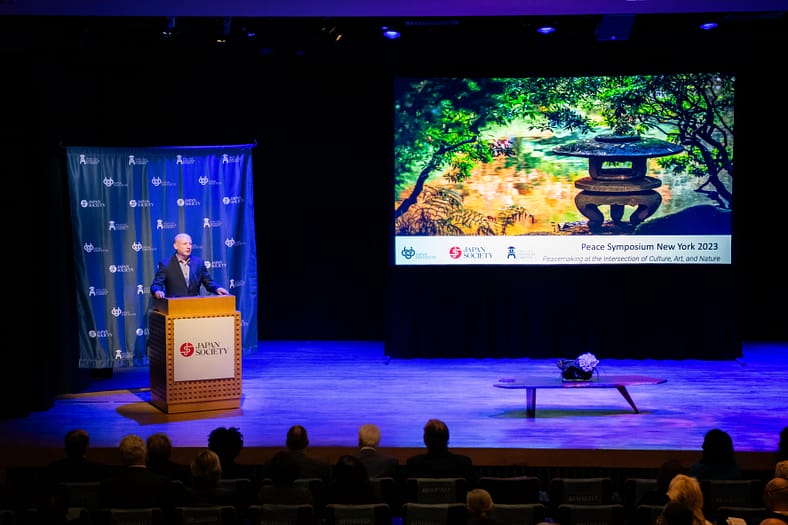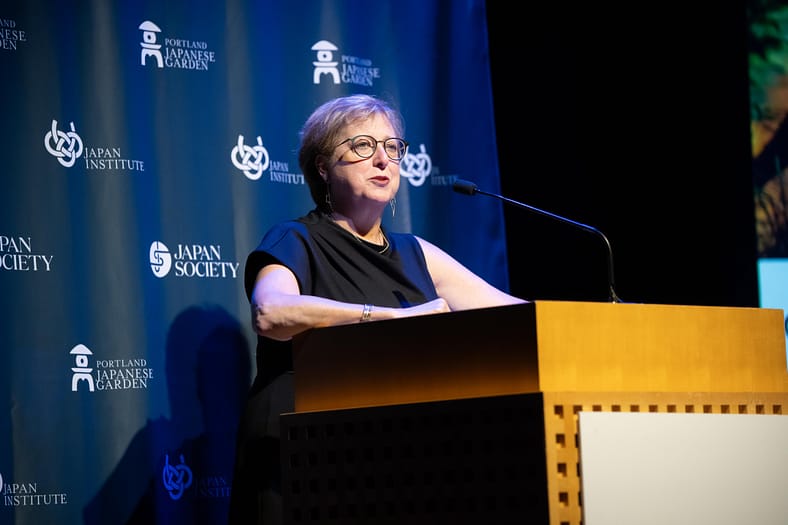
Japan Institute’s Peace Symposia series is the signature programming of the organization’s International Exchange Forum. These symposia, which have taken place in global capitals such as Tokyo and London, inspire conversations about peace through the lens of cultural diplomacy by exploring the interplay between and convergence of landscapes, architecture, and arts.
On September 21, the United Nations’ International Day of Peace, Japan Institute held its third Peace Symposium at Japan Society’s headquarters in New York, New York. Global thought leaders presented on topics related to the symposium’s theme of “The Intersection of Culture, Art, and Nature.” The following captures some highlights of the program through quotes:
Caryl Stern, Chief Impact Officer at LionTree & Former CEO, UNICEF USA

“Peace is not merely the absence of conflict. It’s a state of harmony, understanding, and cooperation. Peace is not passive. It requires active engagement and dialogue. It’s about respecting diversity and seeking nonviolent solutions to conflict. Peace is not achieved overnight. It requires patience, empathy, a willingness to listen to different perspectives. And as global citizens, we have a responsibility to promote peace within our own communities and way beyond.”
Hiroshi Senju, Artist

“I feel that the creative process of art itself is a process of peacemaking… The process of creating an artwork is to accept all the forms and colors that appear on a surface to create harmony and to create a well-balanced world. … Having studied the history of art around the world, I feel that artists have depicted light in times of darkness, openness in times of need, and the harmony of different values in times of war. I believe that art is about pointing out the failures of our times and preserving them through images, showing the world as we would like it to be.”
His Excellency, Ambassador Osamu Yamanaka, Deputy Permanent Representative of Japan to the United Nations

“Today’s theme, ‘Peacemaking at the Intersection of Culture, Art, and Nature,’ requires a deep sense of unity. As the UNESCO [United Nations Educational, Scientific and Cultural Organization] constitution says, since wars begin in the minds of man, it is in the minds of man that the defense of peace must be constructed. Though, we first have to replace the word ‘man’ with ‘people.’ We have to start constructing the defensive peace by deepening our sense of unity, which easily comes when art and culture gathers us together. In this regard, Japanese art is the great connector, leaving intentional space for artists and viewers to partake in reflective contemplation, offering a chance for dialogue.”
Ayanna Behin, Director of Training & Conflict Consulting, New York Peace Institute

“As I’ve been a mediator, I’ve come to see that there are many truths. And that part of getting to peace is understanding, sharing our truth, having it be heard and understood, and then listening to somebody else’s truth and making a shift in perspective. And maybe at the end of your mediation session, your restorative practice, your facilitated dialogue, you realize, ‘Okay, we are not going to see eye-to-eye here.’ That’s okay too, right? Because you have come to better understand yourself and them.”
Christopher Willis, Chief Director of National Botanical Gardens, South African National Biodiversity Institute (SANBI)

“We have adopted forest bathing in [Kirstenbosch National Botanical Garden in South Africa], shinrin yoku, which is basically the positive effects of nature on human health and wellbeing. It was a concept that we hadn’t really heard of, but through engagement with other communities, we’ve heard about this. And I think using trees as a space for improving psychological and physiological conditions, lowers your blood pressure, just walking in a forest. I think these spaces are very critical for enhancing better lifestyles and conditions.”
Robert Lear, Senior International Producer, Global Arts Corps

“I was very interested to listen to a variety of speeches today and comments particularly on the indirect relationship between parks, gardens, and peacemaking. It’s not self-evident. And what I came away with was that it is not an issue of time, but an issue of space. … There is this kind of meditative reflective impetus that is created by gardens. The more that people use gardens and they become part of not just someplace you visit, but someplace you live, there is the opportunity to be reflective. And in that reflection, there is the possibility of peace or the determent of conflict.”